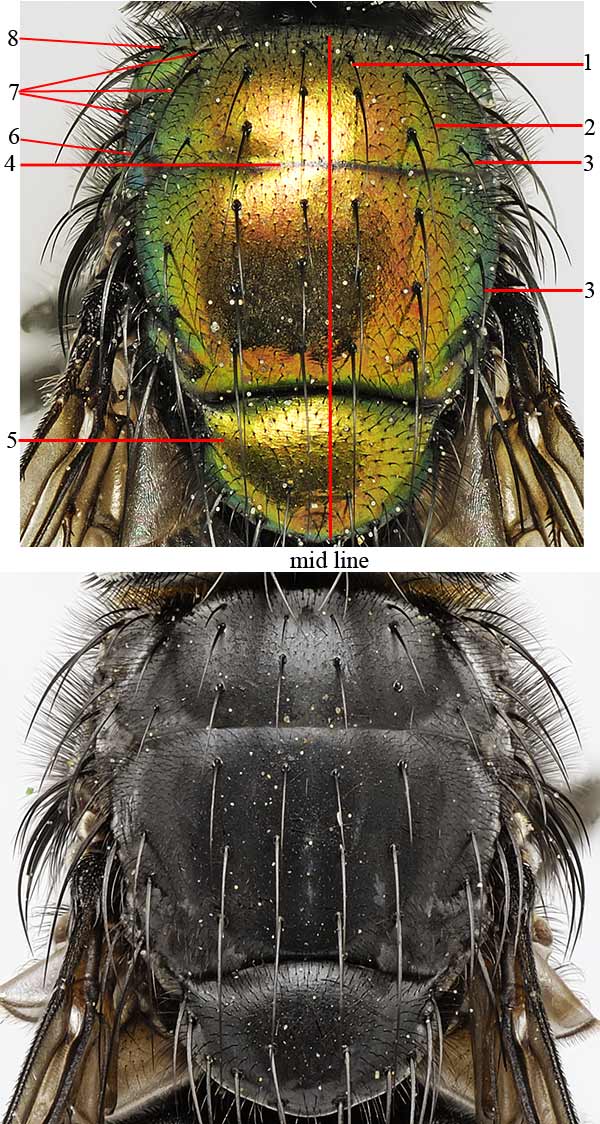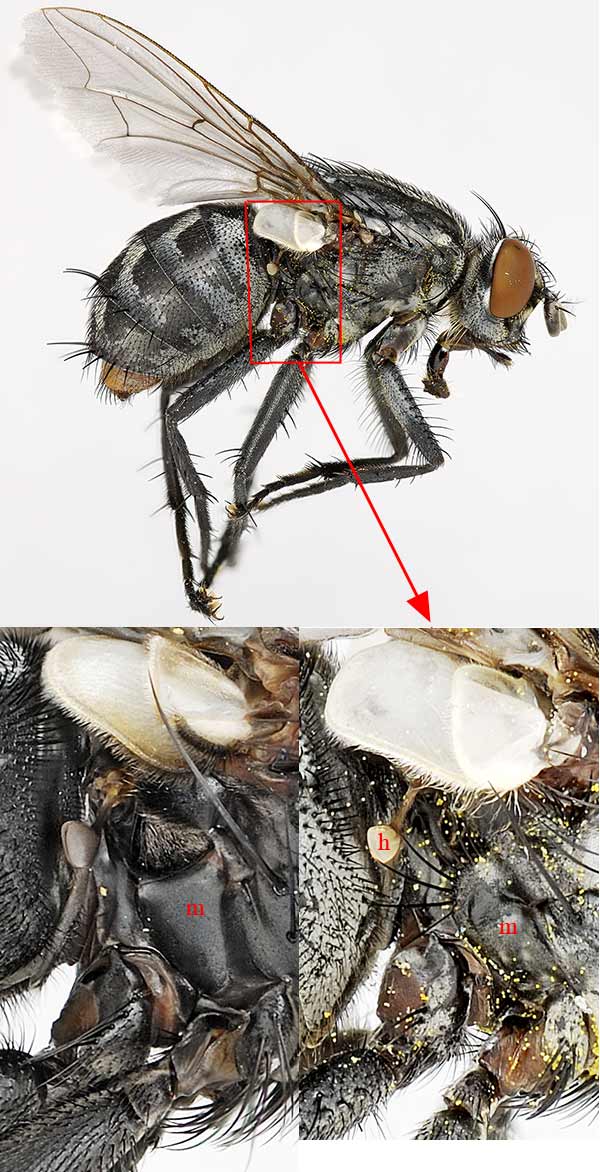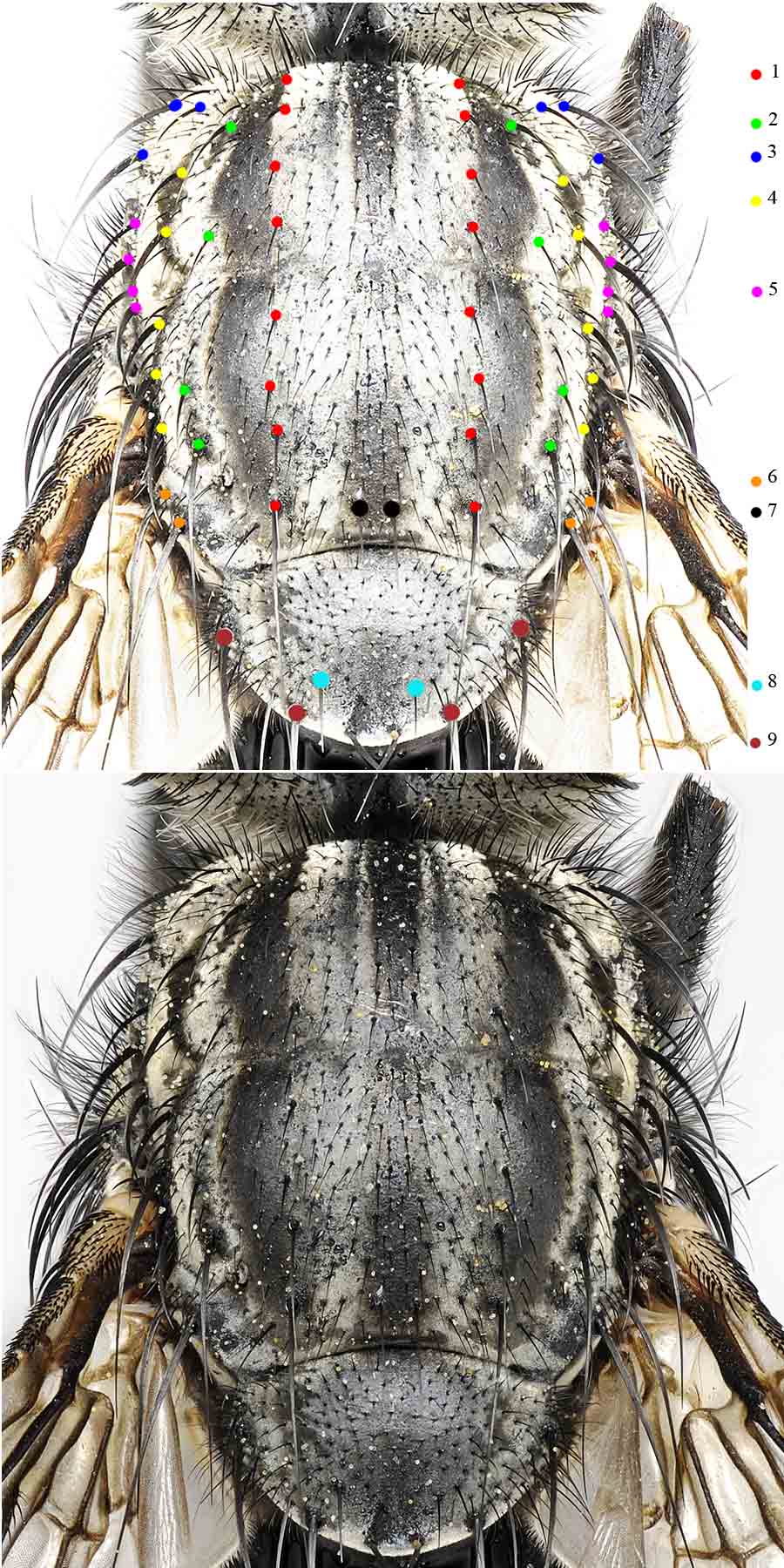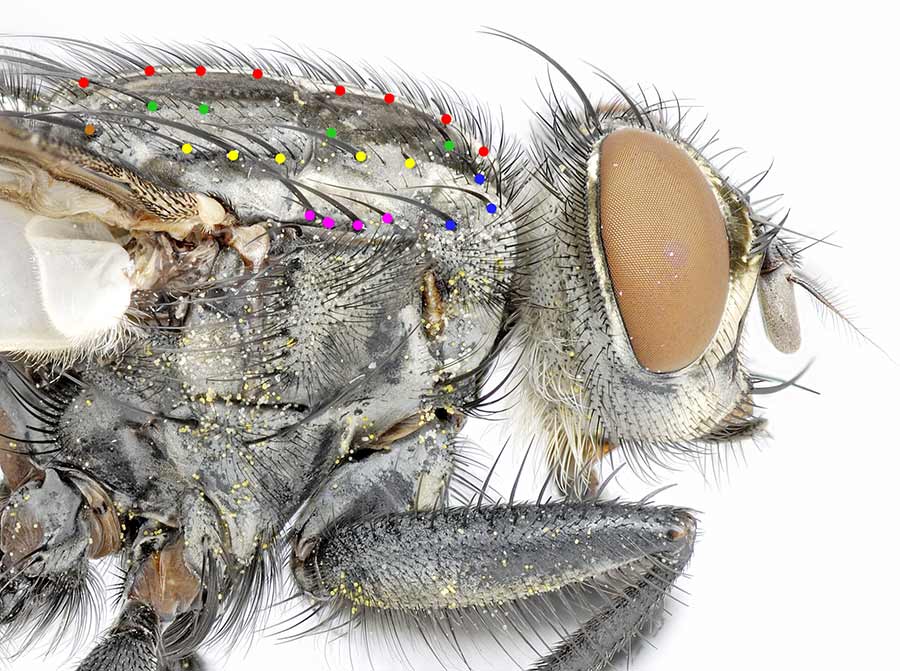Diptera.info :: General Diptera forums :: Overviews
Who is here? 1 guest(s)
|
Thoracic Setae
|
|
| Tony T |
Posted on 26-09-2007 22:15
|
|
Member Location: New Brunswick, Canada Posts: 664 Joined: 08.02.07 |
The number and position of the setae on the thorax of Calliphorids (at least in North America) are critical for the determination of species. I made this figure to help me identify local Calliphorids and thought that it may be useful to others. The setae are named based on their position and location, anterior-to or posterior-to the transverse suture (4). The setae are similar (repeated) either side of the mid-line. - 1 acrostichal setae; presutural (2 in this fly) and postsutural (3 in this fly) - 2 dorsocentral setae; presutural (3 in this fly) and postsutural (3 in this fly) - 3 intra-alar setae; presutural (1 in this fly just above transverse suture) and postsutural (2 in this fly) - 4 transverse suture - 5 scutellum Less important for species identification are: - 6 presutural seta - 7 posthumeral setae - 8 humeral lobe with humeral setae Top fly is Lucilia silvarum Bottom fly with a similar configuration Calliphora vomitoria Tony T attached the following image:  [146.14Kb] Edited by Tony T on 27-09-2007 12:56 |
|
|
|
| Paul Beuk |
Posted on 27-09-2007 07:02
|
|
Super Administrator Location: Netherlands Posts: 19403 Joined: 11.05.04 |
Nice pictures. I still need to add the terms with good illustrations to the Glossary, so if I can use these... Just one question: Isn't the usual term 'presutural' rather than 'anterosutural'? Paul - - - - Paul Beuk on https://diptera.info |
| crex |
Posted on 27-09-2007 09:02
|
|
Member Location: Sweden Posts: 1996 Joined: 22.05.06 |
You should also mention the commonly used abbreviations for these terms. |
|
|
|
| conopid |
Posted on 27-09-2007 10:54
|
|
Member Location: United Kingdom Posts: 1039 Joined: 02.07.04 |
Tony, Paul, This is really, extremely useful. It's much, much better than the line drawings one usually has to try and interpret. Can I suggest, if Tony has time over the coming months/years that the site contains a section where the major families are featured in this way. It would be useful to also provide a glossary of setae terminology, so that workers using different terms can check and be clear about the bristles that they are interpreting. A particlular request - any chance of some similarly annotated photos for Sarcophagidae and Lonchaeidae - dorsal and lateral ? (Pretty please). lonchaeidae are causing me particular problems at the moment. I can never convince myself that I am looking at the correct bristles in some instances and so I am probably making many elementary mistakes. Photos of the fantastic quality seen here would really help with this issue.  If you can undertake any of this work Tony, the amateur dipterist community will forever be in your debt! Edited by conopid on 27-09-2007 11:12 Nigel Jones, Shrewsbury, United Kingdom |
|
|
|
| jorgemotalmeida |
Posted on 27-09-2007 12:11
|
|
Member Location: Viseu - PORTUGAL Posts: 9296 Joined: 05.06.06 |
I'm doing that right now... conopid.  |
| Tony T |
Posted on 27-09-2007 13:02
|
|
Member Location: New Brunswick, Canada Posts: 664 Joined: 08.02.07 |
Paul Beuk wrote: Nice pictures. I still need to add the terms with good illustrations to the Glossary, so if I can use these... Just one question: Isn't the usual term 'presutural' rather than 'anterosutural'? Don't know where I got "ante..." from, changed to "pre". Use them anyway you wish. This is all new to me, tabanids don't bother with setae  So, if someone tells me the abbreviations, I will add them. Working on the other families, 1st need to get decent photos. |
|
|
|
| jorgemotalmeida |
Posted on 27-09-2007 13:16
|
|
Member Location: Viseu - PORTUGAL Posts: 9296 Joined: 05.06.06 |
Abbreviations for the thorax and leg. --- not sure specially for intra-alar and scutellum --- I will update this throughout the day. THORAX Warning: setae is the plural form, seta is the singular form. Acrostichal(s) seta(e) = ac seta(e). Or Ac seta(e). Dorsocentral(s) seta(e) = dc seta(e). Or Dc seta(e). Intra-alar(s) seta(e) = ia seta(e) not intralar or Intra alar. Postsutural dorsocentral(s) seta(e) = post sut dc seta(e) Presutural dorsocentral(s) seta(e) = pre sut dc seta(e) Scutellum = sctl Scutum = sct Transverse suture = ts (on scutum) Observations: Microtrichium (plural: MICROTRICHIA) = hair like elements (without alveolus) -- erroneously called HAIRS. The hairs are a feature strictly of mammals. Macrotrichium (plural: MACROTRICHIA) = bristle or seta. (plural: BRISTLES or SETAE). It has always an alveolus. Very strong macrotrichia are spurs or spines. TAKE A LOOK at the second photo - Calliphora vomitoria (see above), it shows very clearly an alveolus in the base of the presutural dorsocentral seta/bristle at our right. It lost the bristle, indeed. See the photos of Mycetophilidae in gallery to find the spurs on tibia. seta (plural: SETAE) = bristle (plural: BRISTLES) small seta/bristle = setula (plural: SETULAE) LEG The leg is composed by COXA, TROCHANTER, FEMUR, TIBIA, TARSUS (plural: TARSI). This reflects the order of a leg since the thorax. Femur 1 = f1 -- the anterior femur (the first one that appears after the head) / Femur 3 = f3 -- the posterior femur (the first one that appears before the genitalia). Tibia 1 = t1 -- the same as femur. Tarsus 1 = ta1 -- the first segment of the tarsomere after the tibia. There are 5 segments in tarsus (tarsomeres). The first is called metatarsus or basitarsus; the last one is distitarsus. Tarsus have five segments, the so-called, tarsomeres (going outward from tibia to the extremity of the leg). The distitarsus has sclerite bearing 2 claws. Edited by jorgemotalmeida on 28-09-2007 09:24 |
| Tony T |
Posted on 27-09-2007 15:49
|
|
Member Location: New Brunswick, Canada Posts: 664 Joined: 08.02.07 |
The primary character that separates the Families: Tachinidae, Calliphoridae, Sarcophagidae, and Rhinophoridae from similar-looking flies in the Families: Muscidae, Anthomyiidae, Scathophagidae; and many other families is the presence of a row of setae at the posterior edge of the meron (m). The meron is a sclerite on the pleuron of the mesothorax lying just above and posterior to the coxa of the middle leg, below the calypteres and below and anterior to the halter. - h halter - m meron Top image is a Sarcophagid, Bottom image is a Muscid (left), note the bare meron (m); and, on the right, a close-up of the Sarcophagid. Note the obvious 4 long black setae on the posterior edge of the meron (m). Tony T attached the following image:  [116.8Kb] |
|
|
|
| conopid |
Posted on 27-09-2007 15:50
|
|
Member Location: United Kingdom Posts: 1039 Joined: 02.07.04 |
 Tony and Jorge - this is going to be an invaluable resource. Many thanks for your work. Tony and Jorge - this is going to be an invaluable resource. Many thanks for your work.
Edited by conopid on 27-09-2007 15:51 Nigel Jones, Shrewsbury, United Kingdom |
|
|
|
| Tony T |
Posted on 29-09-2007 18:03
|
|
Member Location: New Brunswick, Canada Posts: 664 Joined: 08.02.07 |
conopid wrote: A particlular request - any chance of some similarly annotated photos for Sarcophagidae...... ?. Dorsal view of thorax of a Sarcophagid, 7 September 2007, NB, Canada. The setal pattern is much less clear than that of Calliphorids (see previous image in this thread) 1: dc s, dorso central seta; usually 3-4 presutural dc s (presut dc s), and 3-4 postsutural dc s (psut dc s). 4 presut dc s and 4 psut dc s in this fly 2: ial s, intra-alar seta; usually 1-2 presutural ial s (presut ial s), and 1-2 postsutural ial s (psut ial s). 2 presut ial s and 2 psut ial s in this fly 3: pprn s, postpronotal seta; usually 2-4 setae. 3 pprn s in this fly 4: spal s, supra-alar seta; usually 1-2 presutural apal s, and 3 postsutural spal s. 2 presut spal s and 3 psut spal s in this fly 5: npl s, notopleural seta; usually 4 in Sarcophaginae, just 2 in Miltogramminae. 4 npl s in this fly 6: pal s, post alar seta; 2 in Sarcophagidae; 2 pal s in this fly. 7: psut acr s; postsutural acrostichal seta; usually a prescutellar pair; as here (1 psut acr s each side of mid-line). 8: ds sctl s; discal scutellar seta; just 1 ds sctl s on each side of mid-line 9: l sctl s; lateral scutellar seta; usually 2 or 3. 2 l sctl s in this fly. Note the absence of presutural acrostichal seta and the reduction in number of postsutural acrostichal setae. Tony T attached the following image:  [186.11Kb] |
|
|
|
| Kahis |
Posted on 29-09-2007 18:16
|
|
Member Location: Helsinki, Finland Posts: 1999 Joined: 02.09.04 |
Great job, guys & girls & others (just trying to cover all bases here  ) )The color spots showing which seta is which is very incluttered - an almost perfect illustration for the purpose. It would be perfect of you would have the names directly in the legend on the right side. Having to look up the number adds an unnecessary step. Alternative names for some setae: first postsutural supra-alar -> prealar seta (logical - as Tony's illustration shows, it is in front of the wing base. The strength (or absence) of this seta is frequently used as a key character in Muscidae. Kahis |
| Tony T |
Posted on 29-09-2007 20:22
|
|
Member Location: New Brunswick, Canada Posts: 664 Joined: 08.02.07 |
Kahis wrote: It would be perfect of you would have the names directly in the legend on the right side. Having to look up the number adds an unnecessary step. Are you familiar with the expression "there's method in my madness"?  Abbreviations or names on an image become a big problem if a name is incorrect; it cannot be easily changed. The legend on the right side is part of the image. It is easy to change the accompanying text  . . |
|
|
|
| Tony T |
Posted on 30-09-2007 14:52
|
|
Member Location: New Brunswick, Canada Posts: 664 Joined: 08.02.07 |
Lateral view of Sarcophagid thorax; see above dorsal image for legend to colour coding.
Tony T attached the following image:  [109.01Kb] |
|
|
|
| conopid |
Posted on 30-09-2007 22:03
|
|
Member Location: United Kingdom Posts: 1039 Joined: 02.07.04 |
Oh wonderful. Thank you Tony and all. I shall be tackling a few Sarcophagids tomorrow night, armed with this excellent work. 
Nigel Jones, Shrewsbury, United Kingdom |
|
|
|
| Tony T |
Posted on 04-10-2007 20:12
|
|
Member Location: New Brunswick, Canada Posts: 664 Joined: 08.02.07 |
7 September 2007, NB, Canada Hopefully a reasonably typical species. So many setae and hairs that I could not interpret the lateral view  ; even this dorsal view was not easy to interpret; from what I read there are supposedly just 5 pprn s but this fly appears to have 6 ; even this dorsal view was not easy to interpret; from what I read there are supposedly just 5 pprn s but this fly appears to have 6 same fly as wing detail posted on 02-10-2007 03:07:- HERE Tony T attached the following image:  [168.5Kb] |
|
|
|
| Susan R Walter |
Posted on 05-10-2007 12:52
|
|
Member Location: Touraine du Sud, central France Posts: 1802 Joined: 14.01.06 |
I go away for a few weeks and come back to all this splendid work - these pages are really going to take some hits  Very well done to Tony T and Jorge for taking the time to do this for all of us. Susan |
| Jump to Forum: |













